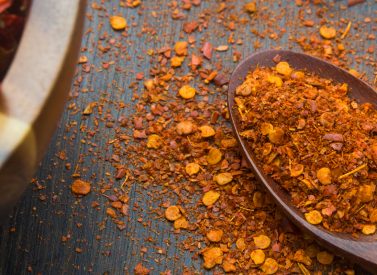Scientific Name: Capsicum frutescens/annuum
Constituents:
- Capsaicinoids (capsaicin, capsaicin, dihydrocapsaicin, & nordihydrocapsaicin)
- Carotenoids & Tocopherols
- Steroidal saponins (capsicidins)
Medicinal actions:
- Analgesic
- Antimicrobial
- Antioxidant
- Cardiac Tonic
- Carminative & Antispasmodic
- Circulatory stimulant
- Diaphoretic
- Rubefacient (counter-irritant)
Mechanism of Action & Pharmacology:
- Capsaicinoids (mainly capsaicin) stimulate circulation, especially towards the gastrointestinal mucosa which is sensitive to capsaicin, promoting blood flow to the area and increasing vascular permeability. Capsaicin also inhibits acid secretion, stimulates alkali and mucus secretion, and particularly stimulates gastric mucosal blood flow which helps in prevention and healing of gastric ulcers.
- Capsaicin produces a burning sensation with tissues it comes into contact, which occurs via binding to transient receptor potential vanilloid 1 (TRPV1) receptor, an ion channel-type receptor, which can be stimulated by heat and physical abrasion. Cayenne is sometimes considered a ‘counter-irritant’ because the initial neuronal excitation evoked by it is followed by a long-lasting refractory period, during which the previously excited neurons are no longer responsive to a broad range of stimuli (a process known as defunctionalization, which can be exploited for therapeutic use in various painful conditions). Also appears to stimulate excessive production of the neuropeptide substance P (a neurotransmitter involved in pain, inflammation and pruritus) by peripheral neurons to the point of depletion from sensory afferent nerves, creating temporary analgesic effects.
- Extract has demonstrated potent anti-inflammatory and antioxidant effects and proved useful in conditions such as rhinitis and allergic airway inflammation.
Pharmacy:
- Tincture
- Capsules
- Topical: Ointment and creams – apply as needed
- Note: All internal forms of capsicum are best tolerated if taken with food
Safety & Toxicity Concerns:
- Symptoms of internal toxicity include: heartburn, anal burning, and gastric erosions, digestive upset, and diarrhea. Internal toxicity may occur if ingested in quantities greater than the therapeutic doses away from food. May cause transient increase in heart rate and blood pressure.
- External adverse effects may occur if extracts are highly concentrated in capsaicin and are applied for a prolonged period of time. Adverse reactions to topical application include: burning, stinging, erythema, heat, pain, and with prolonged use may cause permanent loss of sensory nerve function in the area of application. Avoid application to eyes and/or mucosal membranes.
- Avoid internal use in active duodenal ulcer, GERD, acute diarrhea, acute cholelithiasis, and severe hypertension.
- During pregnancy doses should not exceed normal dietary levels, and caution should be used during lactation.
- Avoid in allergy to Solanaceae family
- Note: Should be reserved for use when significant stimulation is required. Is indicated in gastric and digestive insufficiency, but relatively contraindicated in ulcerations and inflammations of the digestive tract.
Interactions:
- High doses have been shown to increase the activity of two hepatic enzymes in rats (glucose-6-phosphate dehydrogenase & adipose lipoprotein lipase), thus the hepatic metabolism of some drugs may be affected.
- Use caution with concomitant use of MAOIs, anti-diabetic agents, anti-arrhythmics, anti-hypertensives, and ACE inhibitors (may increase cough even with topical applications).
- Avoid concomitant use with cocaine.
- Internally could theoretically potentiate anticoagulants (may decrease oral bioavailability of aspirin), and increase drug level of theophylline.
- When added to other herbs will enhance their stimulatory effects (e.g. is a good addition to formulas in order to enhance their circulation and stimulatory effects of other herbs.








